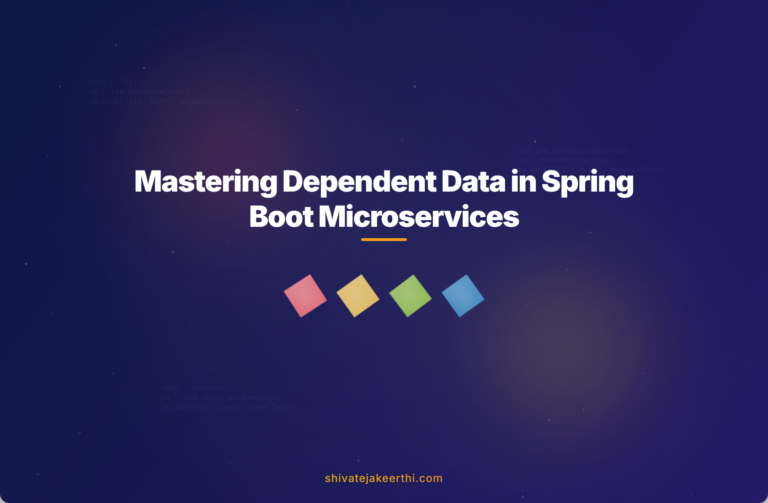When you’re building a web application using microservices, it’s common to split responsibilities across separate components. You might have one service handling movies (the movie microservice) and another one managing shows (the show microservice). But this separation creates challenges when you’re dealing with dependent data.
Imagine a scenario—you’re managing movies and their screening schedules. Each movie has multiple associated shows. How do you effectively save a show in one microservice yet link it neatly to a movie in another? Let’s break this down practically using Spring Boot as your framework.
Defining the Movie Entity in Spring Boot
First, let’s take a look at how you might define the movie entity. Typically, your Movie microservice has a MovieEntity class with the following setup:
@Entity
@Table(name = "movies")
public class MovieEntity {
@Id
@GeneratedValue(strategy = GenerationType.IDENTITY)
private Long movieId;
private String title;
private String genre;
private String duration;
@ElementCollection
private List showIds = new ArrayList<>();
// Getters and setters omitted for brevity
}
You’ll notice we use @Entity and @Table annotations to map the class to a database table. The showIds list tracks associated shows via their IDs rather than the full objects, which helps to minimize data coupling.
Managing Associations with MovieService
Now, how do we add a new show to an existing movie? Your MovieService can manage this association cleanly by utilizing methods like this one:
@Service
public class MovieService {
@Autowired
private MovieRepository movieRepository;
public void addShowToMovie(Long movieId, Long showId) {
MovieEntity movie = movieRepository.findById(movieId)
.orElseThrow(() -> new RuntimeException("Movie not found with id: " + movieId));
movie.getShowIds().add(showId);
movieRepository.save(movie);
}
}
This straightforward method retrieves your movie entry from the database by its ID, appends the new show’s ID and then saves the updated entity.
The Show Entity: Keeping Things Independent
On the other side, the Show microservice has a separate entity—ShowEntity. Here’s an example structure:
@Entity
@Table(name = "shows")
public class ShowEntity {
@Id
@GeneratedValue(strategy = GenerationType.IDENTITY)
private Long showId;
private Date showTime;
private Long movieId; // Reference to movieId from Movie microservice
// Additional fields & getters/setters omitted for simplification
}
Notice that ShowEntity keeps track of Movie via movieId, not by holding a full movie object. This helps reduce dependencies between microservices, easing maintenance and upgrades down the road.
Linking and Saving Data via ShowService
On to actual logic—how do you add and link a new show effectively? Let’s visit the ShowService, which handles the business logic:
@Service
public class ShowService {
@Autowired
private ShowRepository showRepository;
@Autowired
private MovieFeignClient movieFeignClient; // Feign client for inter-service communication
@Transactional
public ShowEntity addShow(ShowEntity newShow) {
// Validate Movie exists (inter-service call)
boolean movieExists = movieFeignClient.validateMovieId(newShow.getMovieId());
if (!movieExists) {
throw new RuntimeException("Movie does not exist with ID: " + newShow.getMovieId());
}
// Save Show
ShowEntity savedShow = showRepository.save(newShow);
try {
// Link saved Show with Movie
movieFeignClient.addShowToMovie(newShow.getMovieId(), savedShow.getShowId());
} catch (FeignException e) {
showRepository.delete(savedShow); // Rollback if linking fails
throw new RuntimeException("Failed to link Show to Movie, transaction rolled back", e);
}
return savedShow;
}
}
The above method first checks if the movie exists by calling a RESTful microservice using a Feign Client. If validation succeeds, it proceeds to save the Show. If any subsequent linking operation fails, it rolls back the operation to maintain data consistency.
Common Errors and Troubleshooting
A common issue with this approach is encountering errors like FeignException$InternalServerError. Often, this occurs due to incorrect endpoints or improper handling of request/response objects in the Feign Client. To diagnose, always ensure that:
- All REST endpoints are correctly defined and reachable.
- Feign client methods match the target REST API endpoints.
- Correct DTO (Data Transfer Object) classes are used consistently across services.
You can read more troubleshooting guidelines from this useful Stack Overflow thread.
Best Practices for Linking Dependent Data
Managing dependent data across separate microservices can get tricky. Following certain patterns can simplify your development workflow and improve your system’s resilience significantly:
- Use DTOs consistently: Always prefer communicating through Data Transfer Objects (DTOs) rather than sending complete entities, reducing unnecessary payload exposure.
- Avoid storing direct references in lists: If possible, use relations managed outside through queries rather than saving long lists of foreign IDs directly.
- Cascade operations cautiously: Use cascade relationships judiciously to prevent unintended mass deletes or updates across services. Often simple and explicit methods outperform complicated cascades.
Alternative Approaches: Event-Driven Designs
If you find synchronous inter-service calls stressful, consider using event-driven architectures like Kafka or RabbitMQ. Publishing events such as “ShowCreated” or “MovieUpdated” allows microservices to react asynchronously. This is widely regarded as a robust alternative, especially for larger-scale applications.
If you’re exploring asynchronous architectures, you might enjoy this introductory guide to event-driven JavaScript, to learn more about the concept in another context.
Acknowledgments & References
The details in this guide build upon well-established documentation provided by Spring and developer communities. Special appreciation goes to comprehensive documentation provided by Spring Boot, and numerous insightful discussions from Stack Overflow contributors.
Enhancing Your Spring Boot Microservices Architecture
Ultimately, organizing dependent data across microservices boils down to handling communication carefully, clearly defining boundaries, and using effective linking mechanisms. As you experiment, keep transactions simple, ensure robust error handling, thoroughly validate data—and watch your application scale gracefully.
Have you faced challenges handling dependent entities in your microservices? Share your experience or any creative solutions you’ve found helpful in the comments below!



0 Comments